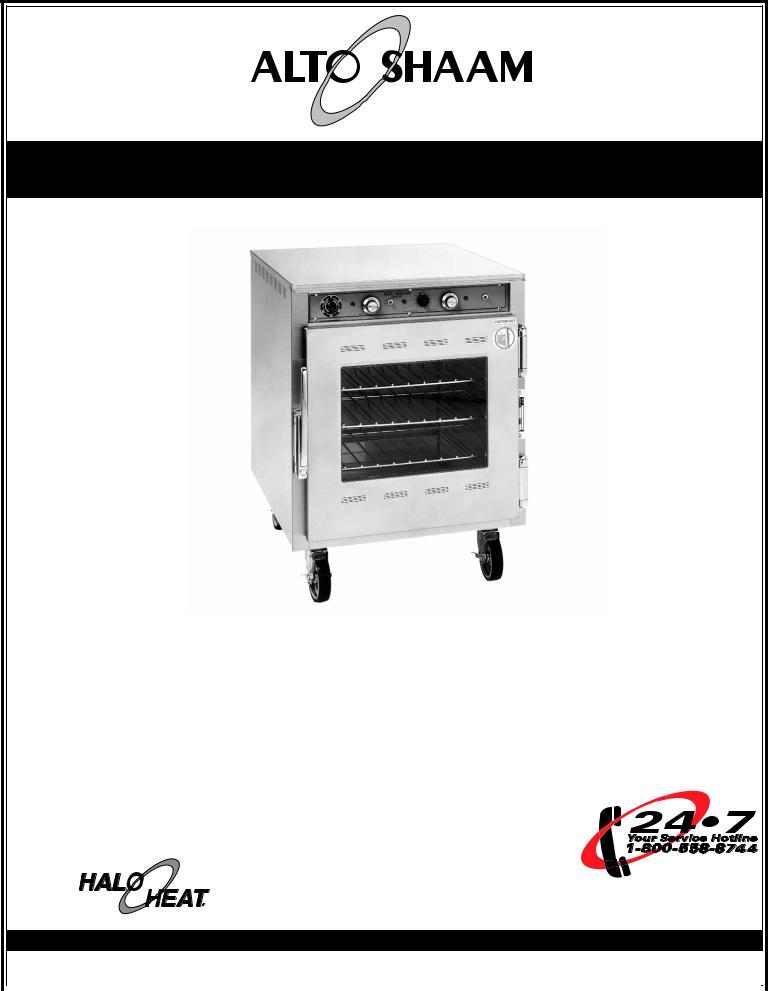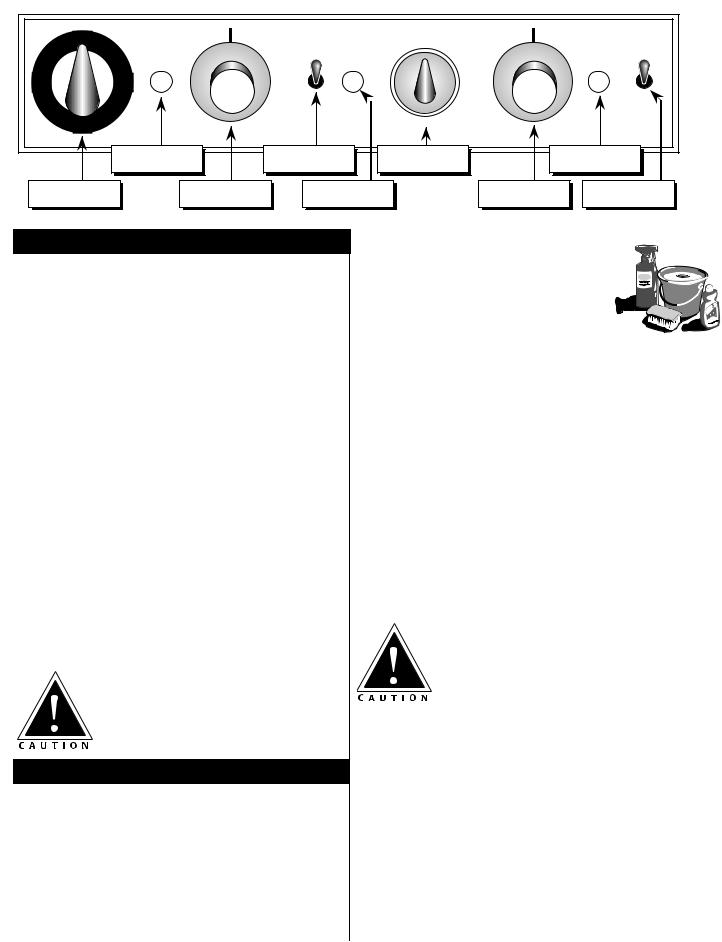Alto Shaam CH-75-DM Service Manual

®
OPERATION and CARE MANUAL
Low Temperature
Cooking and Holding Oven
MODELS: CH-75/DM
W 1 6 4 N 9 2 2 1 W a t e r S t r e e t ● P . O . B o x 4 5 0 ● M e n o m o n e e F a l l s , W i s c o n s i n 5 3 0 5 2 - 0 4 5 0 U . S . A .
|
PHONE: 262.251.3800 |
FAX: 262.251.7067 • 800.329.8744 U.S.A. ONLY |
WEBSITE: |
|
|
|
800.558.8744 U.S.A./CANADA |
262.251.1907 INTERNATIONAL |
www.alto-shaam.com |
|
|
|
|
|
|
|
|
|
|
|
|
|
|
|
P R I N T E D I N U . S . A . |
|
#861 • 6/00 |
||

®
LOW TEMPERATURE COOKING AND HOLDING OVENS
U N PAC K I N G a n d S E T- U P
The Alto-Shaam Cooking and Holding Oven has been thoroughly tested, checked for calibration, and inspected to insure only the highest quality oven is provided. When you receive your oven, check for any possible shipping damage and
report it at once to the delivering carrier.
The oven, complete with unattached items and accessories, may be delivered in one or more packages. Check to insure that all the following items have been received as standard with each unit:
Drip Pan |
Oven Side Racks 40 Watt Appliance Bulb |
Wire Shelves |
External Drip Tray |
Save all the information and instructions packed inside the oven. Complete and return the warranty card to the factory as soon as possible to insure prompt service in the event of a warranty parts and labor claim.
Optional 5" (127mm) casters or 6" (152mm) legs must be installed on the oven before use. For the best service, the oven should be installed level. The oven should NOT be installed in any area where it may be affected by steam, grease, dripping water, high temperatures or any other severely adverse conditions.
I M P O R T A N T : ALL CLAIMS FOR WARRANTY MUST INCLUDE THE FULL MODEL NUMBER AND SERIAL NUMBER OF THE OVEN.
E L E C T R I C A L I N S TA L L AT I O N |
||||
|
|
EXAMPLE |
|
|
SERIAL NUMBER AND WARRANTY CODE |
MAXIMUM RATED |
|||
|
|
|
|
|
IDENTIFICATION MODEL NUMBER |
WATTAGE |
|||
MODEL |
xxx-xx |
|
|
|
SERIAL NO. |
xxxx-xx |
WATTS |
xxxx |
|
VOLTS |
xxx |
AC |
1 PH |
xx HZ |
|
ALTO-SHAAM INC. MILW. WI. PAT. NO. 3521030 |
|
||
MAXIMUM RATED VOLTAGE |
|
MAXIMUM RATED FREQUENCY |
||
1. An oven identification tag is permanently mounted on the oven.
2. Oven models at 120/208-240 volts are dual rated units with a conversion switch mounted under an access cover on the rear of the oven, near the power cord.
With the voltage conversion switch in the 200 volt through 208 volt (UPPER) position, the oven will function properly with a source voltage of between 200 volts and 208 volts.
With the voltage conversion switch in the 220-240 volt (LOWER) position, the unit will function properly with a source voltage of between 220 volts and 240 volts.
NOTE: ALL 208-240 volts units are shipped from the
factory with the voltage conversion switch in the 220-240 volt position.
Ensure that the voltage conversion switch position and the available power source match.
3. This oven must be grounded in accordance with requirements of the National Electrical Code or
ENSURE POWER SOURCE
MATCHES VOLTAGE STAMPED
ON OVEN IDENTIFICATION TAG
applicable local codes.
S TA RT- U P
1. Before operating the oven, clean both the interior and exterior of the unit with a damp cloth and mild soap solution. Rinse well to remove all detergent residue.
2. Clean and install the oven side racks and oven shelves. Shelves are installed with the curved edge toward the back of the oven. Insert the drip pan on the interior bottom surface of the oven.
3. Install External Drip Tray on the front of the oven.
See the drawing on page 5 of this manual for mounting instructions.
4. Before operating the unit with product, become familiar with the operation of the controls. Read the following “Operation” section of this manual and operate the various control functions.
AT NO TIME SHOULD THE INSIDE
OR OUTSIDE OF THE OVEN BE WASHED DOWN,
FLOODED WITH WATER OR LIQUID SOLUTION.
NEVER STEAM CLEAN. SEVERE DAMAGE OR
ELECTRICAL HAZARD COULD RESULT.
Operation and Care Manual #861 |
1 |

OVEN CONTROL PANEL
0 |
|
|
|
OFF |
|
|
|
|
|
|
|
|
|
50 |
10 |
|
|
|
|
|
|
|
|
ON |
|
|
|
|
|
|
OFF |
|
|
|
40 |
20 |
|
|
|
|
|
30 |
|
HOLD |
|
TIMER |
COOK |
|
|
|
|
|
|||
|
Holding |
|
ON/OFF |
Cooking |
|
Cooking |
|
Indicator |
|
Power Switch |
Timer |
|
Indicator |
60 Minute |
|
Hold |
Power ON |
|
Cook |
Oven Light |
Bell Timer |
|
Thermostat |
Indicator |
|
Thermostat |
ON/OFF Switch |
G E N E R A L O P E R AT I O N
1.Turn oven POWER SWITCH ‘ON’.
—POWER ‘ON’ INDICATOR LIGHT will illuminate and will remain lit as long as the Power Switch is in the
‘ON’ position.
2.Set the HOLD THERMOSTAT to the required holding temperature.
—HOLDING INDICATOR LIGHT will illuminate as the Hold Thermostat calls for heat. This process will continue as long as the Power Switch and Hold Thermostat are ‘ON’.
3.Set COOK THERMOSTAT to the required cooking temperature.
4.To preheat the oven, activate the Cook Thermostat by turning the COOKING TIMER clockwise.
—COOKING INDICATOR LIGHT and HOLDING INDICATOR LIGHT will illuminate as the Cook Thermostat calls for heat. This process will continue until the COOKING TIMER cycles to the
‘OFF’ position.
These instructions are basic operational guidelines only. For complete instructions, see the HALO HEAT Hot Deli Guide: Recipe to Success packed with the oven.
DISCONNECT THE CABINET FROM
E Q U I P THE POWER SOURCE B E F O R E C L E A N I N G O R S E R V I C I N G .
E Q U I P M E N T C A R E
Under normal circumstances, this oven should provide you with long and trouble-free service. There is no preventative maintenance required, however, the following Equipment Care Guide will maximize the potential life and trouble-free operation of this oven.
The cleanliness and appearance of this equipment will contribute considerably to operating efficiency and savory, appetizing food. Good equipment that is kept clean works better and lasts longer.
1. C L E A N T H E O V E N D A I L Y .
A. Disconnect the oven from the power source.
B. Remove all detachable items such as wire shelves, side racks, and drip pan. Clean these items separately.
C. Clean the interior metal surfaces of the
cabinet with a damp cloth and any good alkaline or alkaline chlorinated based commercial detergent or grease solvent at the recommended strength. Use a plastic scouring pad or oven cleaner for difficult areas. Avoid the use of abrasive cleaning compounds, chloride based cleaners, or cleaners containing quaternary salts. Rinse well to remove all residue and wipe dry.
NOTE: Never use hydrochloric acid (muriatic acid) on stainless steel.
D. To help maintain the protective film coating on polished stainless steel, clean the exterior of the cabinet with a cleaner recommended for stainless steel surfaces. Spray the cleaning agent on the cloth and wipe with the grain of the stainless steel.
Always follow appropriate state or local health (hygiene) regulations regarding all applicable cleaning and sanitation requirements for equipment.
the inside or outside of the cabinet be washed with water or liquid solution. NEVER STEAM
damage or electrical hazard could result.
2.DO NOT USE THE OVEN IF THE CONTROLS ARE NOT PROPERLY FUNCTIONING.
Refer to the Trouble Shooting Guide located in this manual or call an authorized service technician.
3.CHECK OVERALL CONDITION OF THE OVEN ONCE A MONTH .
Check the oven once a month for physical damage and loose screws. Correct any problems before they begin to interfere with the operation of the oven.
4.CHECK THE COOLING FAN IN THE OVEN CONTROL AREA .
While the oven is warm, check that the cooling fan in the oven control area is functioning. The fan is located on the back of the unit, toward the top.
2 |
Operation and Care Manual #861 |

SANITATION GUIDELINES
Food flavor and aroma are usually so closely related that it is difficult, if not impossible, to separate them. There is also an important, inseparable relationship between cleanliness and food flavor. Cleanliness, top operating efficiency, and appearance of equipment contribute considerably to savory, appetizing foods. Good equipment that is kept clean, works better and lasts longer.
Most food imparts its own particular aroma and many foods also absorb existing odors. Unfortunately, during this absorption, there is no distinction between GOOD and BAD odors. The majority of objectionable flavors and odors troubling food service operations are caused by bacteria growth. Sourness, rancidity, mustiness, stale or other OFF flavors are usually the result of germ activity.
The easiest way to insure full, natural food flavor is through comprehensive cleanliness. This means good control of both visible soil (dirt) and invisible soil (germs). A thorough approach to sanitation will provide essential cleanliness. It will assure an attractive appearance of
equipment, along with maximum efficiency and utility. More importantly, a good sanitation program provides one of the key elements in the prevention of food-borne illnesses.
A controlled holding environment for prepared foods is just one of the important factors involved in the prevention of food-borne illnesses. Temperature monitoring and control during receiving, storage, preparation, and the service of food are of equal importance.
|
|
|
The most |
|
I N T E R N A L F O O D P R O D U C T T E M P E R A T U R E S |
accurate |
|||
|
H O T F O O D S |
|||
|
method of |
|||
DANGER ZONE |
40 ° TO 140 °F |
(4 ° TO 60 °C) |
||
measuring |
||||
CRITICAL ZONE70 ° TO 120 °F(21 ° |
TO 49 °C) |
|||
SAFE ZONE |
140 ° TO 165 °F |
(60 ° TO 74 °C) |
safe |
|
C O L D F O O D S |
temper- |
|||
DANGER ZONE |
ABOVE 40°F |
(ABOVE 4°C) |
atures of |
|
SAFE ZONE |
36°F TO 40°F |
(2°C TO 4°C) |
both hot |
|
F R O Z E N F O O D S |
||||
and cold |
||||
DANGER ZONE |
ABOVE 32°F |
(ABOVE 0°C) |
foods is by |
|
CRITICAL ZONE0° TO 32°F(-18° TO 0°C) |
||||
internal |
||||
SAFE ZONE |
0°F OR BELOW |
(-18°C OR BELOW) |
||
product temperature. A quality thermometer is an effective tool for this purpose and should be routinely used on all products that require holding at a specific temperature.
A comprehensive sanitation program should focus on the training of staff in basic sanitation procedures. This includes personal hygiene, proper handling of raw foods, cooking to a safe internal product temperature, and the routine monitoring of internal temperatures from receiving through service.
Most food-borne illnesses can be prevented through proper temperature control and a comprehensive program of sanitation. All these factors are important to build quality service as the foundation of customer satisfaction. Safe food handling practices to prevent food-borne illness is of critical importance to the health and safety of your customers. HACCP, an acronym for Hazard Analysis (at) Critical Control Points, is a quality control program of operating procedures to assure food integrity, quality, and safety. Taking steps necessary to augment food safety practices are both cost effective and relatively simple. While HACCP guidelines go far beyond the scope of this manual, additional information is available by contacting the USDA/FDA Food-borne Illness Education Information Center at (301)504-6803.
GENERAL HOLDING GUIDELINES
Chefs, cooks and other specialized food service personnel employ varied methods of cooking. Proper holding temperatures for a specific food product must be based on the moisture content of the product, product density, volume, and proper serving temperatures. Safe holding temperatures must also be correlated with palatability in determining the length of holding time for a specific product.
Halo Heat maintains the maximum amount of product moisture content without the addition of water, water vapor, or steam. Maintaining maximum natural product moisture preserves the natural flavor of the product and provides a more genuine taste. In addition to product moisture retention, the gentle properties of Halo Heat maintain a consistent temperature throughout the cabinet without the necessity of a heat distribution fan, thereby preventing further moisture loss due to evaporation or dehydration.
In an enclosed holding environment, too much moisture content is a condition which can be relieved. A product achieving extremely high temperatures in preparation must be allowed to decrease in temperature before being placed in a controlled holding atmosphere. If the product is not allowed to decrease in temperature, excessive condensation will form increasing the moisture content on the outside of the product.
Most Halo Heat Holding Equipment is provided with a thermostat control between 60° and 200°F (16° to 93°C). If the unit is equipped with vents, close the vents for moist holding and open the vents for crisp holding.
H O L D I N G T E M P E R A T U R E R A N G E
MEAT |
FAHRENHEIT |
CELSIUS |
BEEF ROAST — Rare |
140°F |
60°C |
BEEF ROAST — Med/Well Done |
160°F |
71°C |
BEEF BRISKET |
160° — 175°F |
71° — 79°C |
CORN BEEF |
160° — 175°F |
71° — 79°C |
PASTRAMI |
160° — 175°F |
71° — 79°C |
PRIME RIB — Rare |
140°F |
60°C |
STEAKS — Broiled/Fried |
140° — 160°F |
60° — 71°C |
RIBS — Beef or Pork |
160°F |
71°C |
VEAL |
160° — 175°F |
71° — 79°C |
HAM |
160° — 175°F |
71° — 79°C |
PORK |
160° — 175°F |
71° — 79°C |
LAMB |
160° — 175°F |
71° — 79°C |
POULTRY |
|
|
CHICKEN — Fried/Baked |
160° — 175°F |
71° — 79°C |
DUCK |
160° — 175°F |
71° — 79°C |
TURKEY |
160° — 175°F |
71° — 79°C |
GENERAL |
160° — 175°F |
71° — 79°C |
FISH/SEAFOOD |
|
|
FISH — Baked/Fried |
160° — 175°F |
71° — 79°C |
LOBSTER |
160° — 175°F |
71° — 79°C |
SHRIMP — Fried |
160° — 175°F |
71° — 79°C |
BAKED GOODS |
|
|
BREADS/ROLLS |
120° — 140°F |
49° — 60°C |
MISCELLANEOUS |
|
|
CASSEROLES |
160° — 175°F |
71° — 79°C |
DOUGH — Proofing |
80° — 100°F |
27° — 38°C |
EGGS —Fried |
150° — 160°F |
66° — 71°C |
FROZEN ENTREES |
160° — 175°F |
71° — 79°C |
HORS D'OEUVRES |
160° — 180°F |
71° — 82°C |
PASTA |
160° — 180°F |
71° — 82°C |
PIZZA |
160° — 180°F |
71° — 82°C |
POTATOES |
180°F |
82°C |
PLATED MEALS |
180°F |
82°C |
SAUCES |
140° — 200°F |
60° — 93°C |
SOUP |
140° — 200°F |
60° — 93°C |
VEGETABLES |
160° — 175°F |
71° — 79°C |
THE HOLDING TEMPERATURES LISTED ARE SUGGESTED GUIDELINES ONLY
Operation and Care Manual #861 |
3 |
